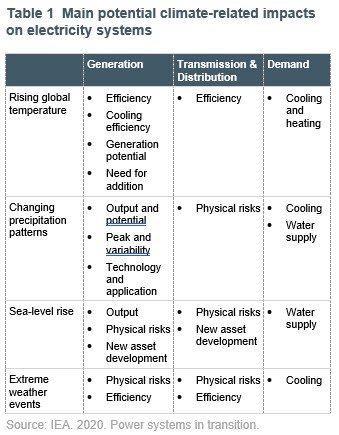ECA INSIGHT >>
While the power sector is the focus of national efforts to decrease GHG emissions, it is also expected to be impacted by climate change. Energy services and resources, as well as seasonal demand, will be increasingly affected by changing trends, increasing variability, greater extremes, and large inter-annual variations in climate parameters in some regions.
Climate change puts electricity systems at risk
Anomalies in climate patterns pose a significant challenge to electricity systems. First, rising global temperatures are expected to lead to a potential increase in cooling demand and decrease in heating demand[1], for which many countries are not prepared, particularly in terms of generation capacity additions.
The impacts of climate change can also reduce efficiency and alter the availability and generation potential of power plants, including both thermal and renewable facilities. For transmission and distribution networks, impacts can result in higher losses, transfer capacity changes and physical damage.
In many countries the increasing frequency or intensity of extreme weather events such as heatwaves, wildfires, cyclones and floods are leading to large-scale outages. The recent outages due to wildfires and heatwaves in California and Australia, and cyclones in Japan and Korea, for example, demonstrate that electricity systems are already exposed to and largely affected by climate hazards. [2] In Summer 2023, high temperatures in the Italian islands reached almost 50°C – causing electrical cables to melt, water pump outages, asphalt road disruptions and wildfires. This jeopardised the health and safety of hundreds of thousands of people, in particular the elderly.[3]
Table 1 below maps out some climate-related impacts on electricity systems, in particular rising global temperatures, changing precipitation patters, sea level rise and extreme weather events.

Power systems must become climate resilient
Power systems need to be able to adapt to and withstand events and changes in climate patterns, operate under the immediate shocks from extreme weather events, and restore the system’s function after an interruption resulting from climate hazards. The adoption of climate resilience strategies as part of network investment, planning and operation can reduce damage and loss from climate impacts. For example, underground transmission and distribution cables, which require a higher upfront cost than above-ground systems, can significantly reduce potential damage from climate impacts and save recovery costs. This is because lines above ground tend to be more vulnerable to climate hazards such as high-speed winds, wildfires, floods and landslides, than underground systems.
Adopting climate resilience measures also contributes to meeting universal electricity access. In Zambia, where only 30-40% of the population have access to electricity, the electricity system is already adversely affected by climate change: shorter rainy seasons and more frequent droughts are posing a challenge to hydropower generation, upon which the country’s electricity generation is heavily reliant on. Both in 2016 and 2019, extreme droughts have led to sharp water level decreases in national dams, prompting blackouts, power rationing and a slowdown in economic development in some places. Climate resilience measures, such as an improved system for monitoring climate hazards and a strategy for diversifying the electricity generating mix, could help ensure reliable access to power networks.
Electricity also plays a critical role in the transition to a low-carbon energy system. Being central to limit future adverse climate change by deploying low-carbon energy technologies, it needs to be resilient to extreme events. A lack of resilience in electricity systems can obstruct clean energy transitions, as some renewable energy technologies could be sensitive to a changing climate. This is especially the case in countries whose electricity infrastructure is vulnerable to changes in climate and extreme weather events.
It is important to embed climate resilience strategies in power system planning
First, for effective power system planning and decision-making, it is imperative to include climate vulnerability assessments of utilities and locations and address their uncertainty. Many sources of climate data are available, and many providers produce climate projections and geospatial mapping that account for various climate change scenarios.
ECA supported Pacific Island States to prepare investment plans to improve the climate resilience of power systems and to develop a tool for Pacific utilities for their climate resilience assessment. The tool was developed with inputs from technical and environmental experts and tailored to the specific needs and use requirements of the Pacific utilities, with the aim help them assess their resilience to climate change and natural disasters.
Second, it is key to ensure electricity system flexibility. This could be done by utilising a variety of distributed energy sources and enabling energy storage in parallel with risk-based adaptive planning and emergency response and recovery planning. The growth of low-carbon power sources should also be supported in this respect, as well as demand-response and digital technologies.
ECA supported the Government of Seychelles in the development of an Integrated Resource Plan (IRP) for the power sector. The work included the development of a demand forecast, evaluation of generation options, import sources, demand-side management options and climate change resilience. ECA focused on the generation and networks least cost plans under alternative scenarios, the development and analysis of policy implementation scenarios, and capacity building.
Finally, climate resilience should be integral to policy-making. According to an IEA report, only nine out of 38 IEA member and association countries include concrete actions on climate adaptation and resilience for every segment of electricity systems.[4] Policy and regulatory efforts are particularly needed to develop appropriate incentives for utilities to facilitate timely investment in resilient electricity systems.
[1] Yalew et al. 2020. Impacts of climate change on energy systems in global and regional scenarios. Nature Energy.
[2] IEA. 2020. Power systems in transition.
[3] Metro UK. 2023. Italian city ‘brought to its knees’ by power cuts caused by heatwave
[4] IEA. 2021. The world’s electricity systems must be ready to counter the growing climate threat.

Marta Calore
Analyst
Marta, who joined ECA in October 2023 from Vivid Economics at McKinsey & Co, specializes in sustainable finance, investment needs for Nationally Determined Contributions, and healthcare-related climate risks. She holds a master’s degree in International Economic Policy from the Paris Institute of Political Studies and a bachelor’s degree in Politics and Economics from the University of Leeds. Her studies, focused on Development Economics, Global Health, and Public-Private Partnerships
